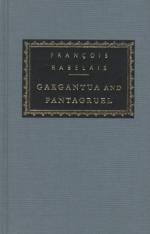Chapter 5.XLII (’This and the next chapter make really but one, tho’ Mr. Motteux has made two of them; the first of which contains but eight lines, according to him, and ends at the words fantastic fountain.’—Ozell.).
How the Priestess Bacbuc showed us a fantastic fountain in the temple, and how the fountain-water had the taste of wine, according to the imagination of those who drank of it.
While we were admiring this incomparable lamp and the stupendous structure of the temple, the venerable priestess Bacbuc and her attendants came to us with jolly smiling looks, and seeing us duly accoutred, without the least difficulty took us into the middle of the temple, where, just under the aforesaid lamp, was the fine fantastic fountain. She then ordered some cups, goblets, and talboys of gold, silver, and crystal to be brought, and kindly invited us to drink of the liquor that sprung there, which we readily did; for, to say the truth, this fantastic fountain was very inviting, and its materials and workmanship more precious, rare, and admirable than anything Plato ever dreamt of in limbo.
Its basis or groundwork was of most pure and limpid alabaster, and its height somewhat more than three spans, being a regular heptagon on the outside, with its stylobates or footsteps, arulets, cymasults or blunt tops, and Doric undulations about it. It was exactly round within. On the middle point of each angle brink stood a pillar orbiculated in form of ivory or alabaster solid rings. These were seven in number, according to the number of the angles (This sentence, restored by Ozell, is omitted by Motteux.).
Each pillar’s length from the basis to the architraves was near seven hands, taking an exact dimension of its diameter through the centre of its circumference and inward roundness; and it was so disposed that, casting our eyes behind one of them, whatever its cube might be, to view its opposite, we found that the pyramidal cone of our visual line ended at the said centre, and there, by the two opposites, formed an equilateral triangle whose two lines divided the pillar into two equal parts.
That which we had a mind to measure, going from one side to another, two pillars over, at the first third part of the distance between them, was met by their lowermost and fundamental line, which, in a consult line drawn as far as the universal centre, equally divided, gave, in a just partition, the distance of the seven opposite pillars in a right line, beginning at the obtuse angle on the brink, as you know that an angle is always found placed between two others in all angular figures odd in number.
This tacitly gave us to understand that seven semidiameters are in geometrical proportion, compass, and distance somewhat less than the circumference of a circle, from the figure of which they are extracted; that is to say, three whole parts, with an eighth and a half, a little more, or a seventh and a half, a little less, according to the instructions given us of old by Euclid, Aristotle, Archimedes, and others.




